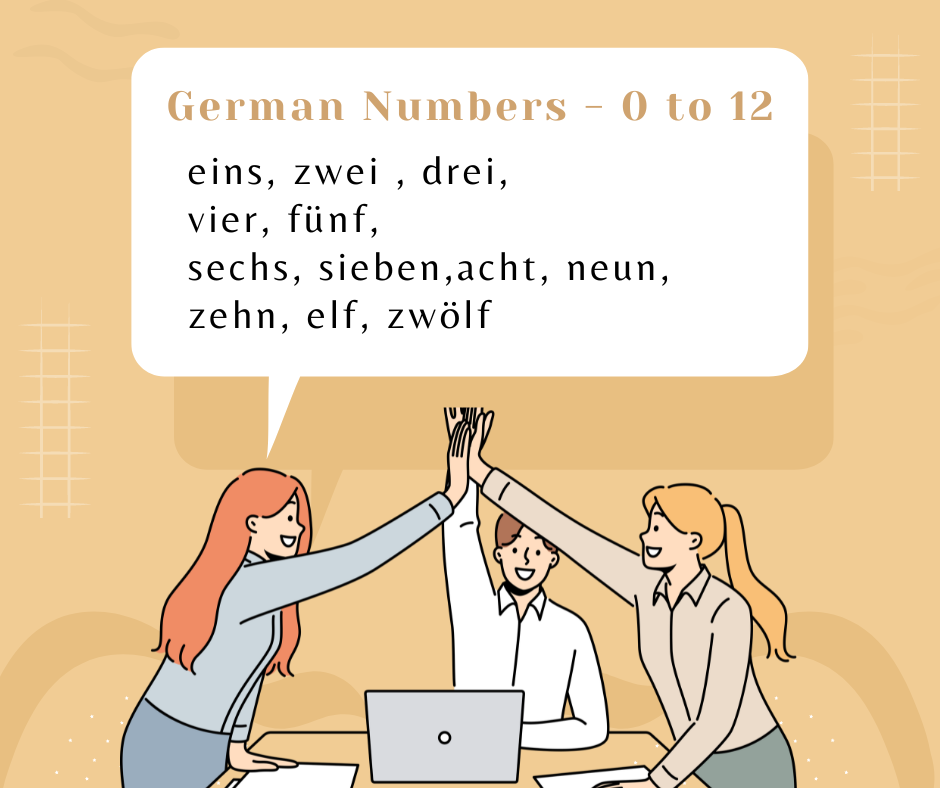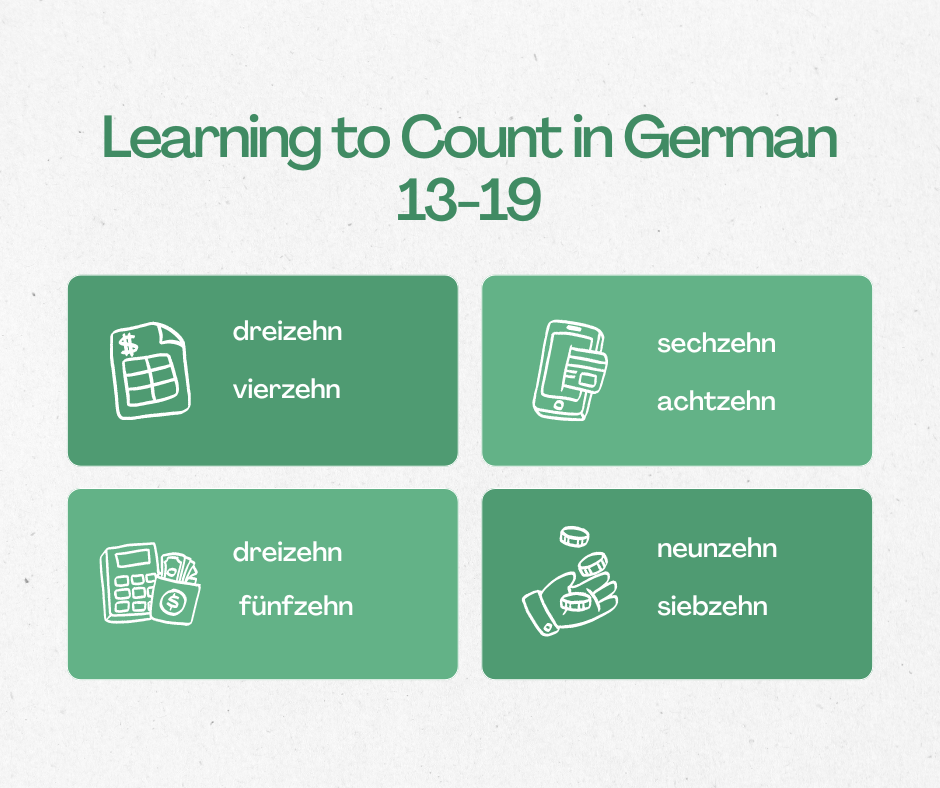Learning German opens new opportunities, such as travel, career advancement, or personal enrichment. Yet one aspect stands firmer than the grammar rules and vocabulary drills: mastering German numbers.
Understanding how to count and pronounce numbers correctly is essential for meaningful conversation and comprehension. From ordering at a café to navigating public transportation, numeracy forms the backbone of daily interactions.
While learning German numbers may initially seem daunting, remember that learning is a journey. With a grasp of basic rules and patterns, you’ll soon find yourself confidently learning to count in German quickly. Learning German numbers can be a fun and rewarding experience. Starting with the basic numbers like ‘null’ and ‘neunzehn’ and moving on to more complex ones will gradually build your confidence and understanding. You can unlock the door to fluency and deeper connections with German culture and people by dedicating time and effort to practice. Join us on this linguistic adventure and take the first step towards mastering the language, opening up a world of possibilities.
Learning to count in German from 0 to 12
Learning the German language starts with numbers. Don’t worry—it is not that hard! Each number from zero to twelve has sound and character, making learning exciting.
To start with the basics, we have numbers from zero to twelve. Unlike the ones that follow a systematic pattern beyond twelve, these numbers must be memorized individually. Here’s a helpful breakdown to get started.
0 – null: This is the starting point, representing nothingness or absence.
1 – eins: Pronounced “ains” marks the beginning of the counting journey.
2 – zwei: Pronounced “tsvai,” it’s the first step into the realm of plurality.
3 – drei: Pronounced “drai,” it signifies the trinity, the trio.
4 – vier: Pronounced “feer” represents stability and foundation.
5 – fünf: Pronounced “fuenf,” it’s halfway to the decade mark, a milestone.
6 – sechs: Pronounced “zejs,” the gateway to the second half of the single digits.
7 – sieben: Pronounced “zi-ben,” lucky number seven, associated with charisma.
8 – acht: Pronounced “ajt,” it’s a symbol of infinity, the never-ending loop.
9 – neun: Pronounced “noin,” it’s the last of the single digits, nearing completion.
10 – zehn: Pronounced “tsen,” it marks the beginning of the double digits.
11 – elf: Pronounced “elf,” it’s the first of the teens, a transition.
12 – zwölf: Pronounced “tsvelf,” it’s the final step before the teens, a bridge.

Learning to Count in German 13-19
As we move past the basic counting numbers in German, a unique pattern stands out for numbers from thirteen to nineteen. These digits have a distinctive sound, with each one sharing a familiar ending: “-zehn,” which means ten, combined with the digit in the one’s place.
Let’s explore these numbers:
13 – dreizehn
Pronounced “drai-tsen,” it combines “drei” (three) with “zehn” (ten), forming a transition into the teen digits.
14 – vierzehn
Pronounced “feer-tsen,” it blends “vier” (four) with “zehn” (ten), continuing the pattern of teen numbers.
15 – fünfzehn
Pronounced “fuenf-tsen,” it merges “fünf” (five) with “zehn” (ten), maintaining consistency within the teen range.
16 – sechzehn
Pronounced “zejs-tsen,” it represents an exception to the pattern, with “sechs” (six) dropping the “s” before “zehn” (ten).
17 – siebzehn
Pronounced “zib-tsen,” it’s another exception, with “sieben” (seven) removing the “-en” before “zehn” (ten).
18 – achtzehn
Pronounced “ajt-tsen,” it follows the pattern, combining “acht” (eight) with “zehn” (ten).
19 – neunzehn
Pronounced “noin-tsen,” it adheres to the pattern, pairing “neun” (nine) with “zehn” (ten).
While most numbers from thirteen to nineteen follow the “-zehn” pattern, there are notable exceptions like “sechzehn” and “siebzehn,” which deviate slightly in spelling while retaining their pronunciation structure.

Learning to Count in German 20 – 100
Counting from twenty to one hundred in German follows a consistent pattern that makes learning easy. The process becomes more structured and systematic as we move into the tens.
Let’s explore these numbers:
20 – zwanzig
Pronounced “tsvantsig,” it signifies the first of the tens, blending “zwei” (two) with “-zig” (a suffix meaning ten)
30 – dreißig
Pronounced “dray-sig,” it introduces a unique spelling with the letter “ß,” which resembles a “B” but is pronounced as “S.”
40 – vierzig
Pronounced “feer-tsik,” it combines “vier” (four) with “-zig” (ten), continuing the pattern.
50 – fünfzig
Pronounced “fuenf-tsik,” it follows the same pattern, adding “fünf” (five) to “-zig” (ten).
60 – sechzig
Pronounced “zex-tsik,” it maintains the pattern, but watch out for the silent “s” in “sechs” (six).
70 – siebzig
Pronounced “zeeb-tsik,” it drops the “en” from “sieben” (seven) before adding “-zig” (ten).
80 – achtzig
Pronounced “akht-tsik,” it aligns with the pattern, combining “acht” (eight) with “-zig” (ten).
90 – Neunzig
Pronounced “noyn-tsik,” it completes the series, pairing “neun” (nine) with “-zig” (ten).
To count up to 100 fluently in German, it’s essential to master the patterns of the tens. There might be slight differences between these numbers’ singular and plural forms. For example, “dreißig” has a “ß” while “siebzig” omits the “en.” Once you’ve mastered the tens, you’ll have a solid foundation for further exploration into the language.

How to say “Hundreds” and “Thousands” in German?
When communicating numbers in German, significantly larger numbers in the hundreds and thousands, following a structured pattern can simplify the process. This allows for clear and precise communication without any confusion.
For numbers in the hundreds:
- Start by stating the digit in the hundreds place, followed by the word “hundert” (meaning “hundred”).
- Then, connect the digit in the tens and one’s places with the conjunction “and” (meaning “and”).
Similarly, for numbers in the thousands:
- Begin by stating the digit in the thousands place, followed by the word “tausend” (meaning “thousand”).
- Next, specify the digit in the hundreds place, followed by “hundert” (meaning “hundred”).
- Finally, include the digit in the tens place.
We use a systematic approach when we read a number out loud in German. For example, “2,350” is pronounced as “zweitausenddreihundertfünfzig” (two thousand, three hundred and fifty). As the numbers get bigger, we need to pay attention to the placement of periods or commas. These help us group the digits accurately and pronounce the number correctly. For instance, “231.795” is pronounced as “zweihunderteinunddreißigtausendsiebenhundertfünfundneunzig” (two hundred thirty-one thousand, seven hundred and ninety-five), with each group of numbers correctly linked and expressed following the same pattern.
Tips to Learn to Count in German
If you want to become good at counting and using numbers in German, you need to practice regularly and surround yourself with the language.
Here are some tips to help you improve your skills:
Find videos or audio recordings of fluent German speakers counting, and record yourself doing the same. Compare your pronunciation to theirs to identify areas for improvement.
Use German numbers in your to-do lists and task planning. This practical application reinforces your learning and integrates numbers seamlessly into your routine.
Watch German movies or TV shows with English subtitles initially, then gradually switch to German subtitles as your comprehension improves. Pay attention to how numbers are used and pronounced in context.
Practice your German numerals by translating license plates while stuck in traffic or waiting in line. This activity reinforces your number skills and keeps you engaged during downtime.
Explore online number games like Digital Dialects or engage in activities like sudoku in German. Turning learning into a game makes it more enjoyable and encourages regular practice.
Expand your numerical vocabulary by learning the names of months and days of the week in German. Use a German calendar to visualize and practically reinforce these terms.
Takeaway
Mastering the art of counting in German is an exhilarating journey that goes beyond just memorizing numbers. It’s about immersing yourself in the language’s unique rhythm and structure. From the foundational numbers to the complexities of larger numerical values, each step in the adventure offers an opportunity for growth and understanding.
The good news is that by following the strategies outlined and engaging in consistent practice, learners like you can cultivate confidence and proficiency in German numerals. Imagine the thrill of counting in German with ease and precision!
There are many ways to reinforce your numerical skills and deepen your comprehension. You can try listening exercises, practical applications in daily life, or gamified learning experiences. Whatever method you choose, you’ll find that learning to count in German opens up a world of possibilities.
So, don’t miss out on this exciting adventure! Embrace the challenges, celebrate the victories, and enjoy the journey of mastering German numbers. With perseverance and a passion for learning, the ability to count in German becomes not just a skill but a gateway to culture and discovery.


 May 13, 2024
May 13, 2024  8 Min
8 Min  No Comment
No Comment 



